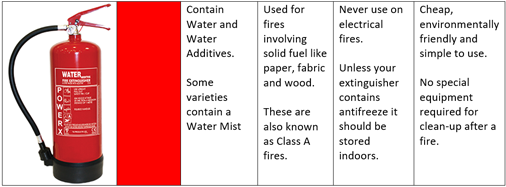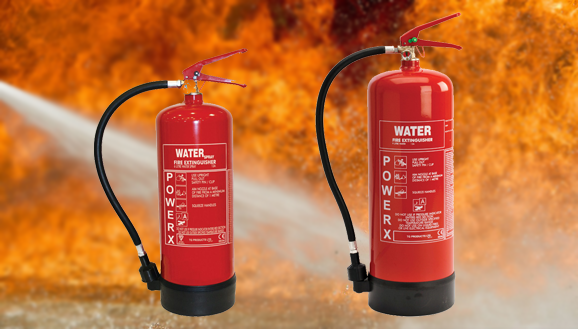Chapter 1- The Water Fire Extinguisher.
In our more than thirty years of business here at Chase Fire our priority is, and has always been the safety of our clients. When a fire breaks out there are two very critical things which can affect the outcome- having the right equipment to tackle it, and knowing how to use it. In this series of articles we’ll be explaining the different types of fire extinguisher and how to use them, starting with the original fire extinguishing tool- the water fire extinguisher.
The Overview:

The Details:
Water Fire Extinguishers:
Water is usually the first thing people think of when it comes to extinguishing a fire, and for thousands of years we have been using it for that purpose. But in an emergency there’s no guarantee that you’ll have something on hand capable of transporting enough water to put the fire out. And that is where our fantastic range of water fire extinguishers comes in. They are inexpensive, portable, and reliable, ready to protect your home or business at any moment.
When a fire breaks out, it is classified into one of five different categories depending on the source of the blaze. The most common category of fire is known as a Class A fire. This class of fire is a fire arising from a solid combustible material- like a fire in a waste paper bin, or soft furnishings like curtains catching alight. Class A fires can spread quickly, and can burn for quite some time depending on the size of the fuel source. A water fire extinguisher is the recommended extinguisher for Class A fires, and only for Class A fires. For each of the other potential types of fire other kinds of extinguishers are more effective.
It is important to note that a water fire extinguisher should never be used on an electrical fire, under any circumstances. The water will further damage the equipment and the resulting puddles can become a shock hazard, making the situation even more dangerous. For all situations involving an electrical fire the electrical equipment should be switched off and unplugged wherever possible. A carbon dioxide extinguisher is specifically recommended for these situations.
Is a Water Fire Extinguisher Right For You?
Because Class A fires are so common, and can start in such a variety of ways, most people can and should make use of a water fire extinguisher. In the home, in the office, in retail, in theatres and in schools, anywhere that clothes, soft furnishings or large amounts of other fire hazards are present.
Public spaces and hotels particularly can benefit from having a water fire extinguisher, even if they already have a sprinkler system fitted. It is a common misconception that a sprinkler system negates the need for a fire extinguisher. Sprinkler systems are usually designed only to go off when the temperature detected reaches 57 degrees. By the time any fire is large enough to raise the temperature to that extent, a significant amount of property damage can already have occurred. If you have a fire extinguisher available, you can put out the fire as soon as it starts, before it has a chance to spread.
What Kinds of Water Fire Extinguisher Are Available?
There are a number of different types of water fire extinguishers on the market, including pure water extinguishers, water additive extinguishers and water mist extinguishers.
Water and water additive extinguishers are the most commonly encountered extinguishers. To meet BS EN3 standards they should be in a completely red canister and have WATER printed clearly on the side information panel. Pure water extinguishers should not be used outside as there is a risk that they might freeze in colder temperatures. Water additive extinguishers usually contain antifreeze among their additions and are therefore safer for outdoor use.
Water mist extinguishers are less common and are a newer addition to the water fire extinguisher set. They produce an incredibly fine spray of water droplets rather than a water jet, and have been tested up to 35kv for use on electrical equipment as the water in this state is non-conductive. These are currently most commonly found in hospitals.
At Chase Fire we stock a range of Water and Water Additive Extinguishers and we are certain we can help you find the right one for your home or business. To talk to one of our friendly advisors please call us on 01785 252568
How Do Water Fire Extinguishers Work?
We all know that water can put out a fire- but do you know how, or why? Understanding the basic mechanisms behind a fire outbreak can help you decide how to best fight it. Fires require four elements to light and sustain. These elements are: a fuel source, oxygen, heat and a chemical (combustion) reaction. If any one of these elements is removed, the fire will be put out. Water fire extinguishers work by cooling the fuel source. When the heat is removed, the fire is too, and the soaked fuel significantly reduces the risk of re-ignition.
How Should I Store and Maintain a Water Fire Extinguisher?
Any fire extinguisher should be properly commissioned and installed by a BAFE certified engineer, after a thorough fire risk assessment has been carried out on your property. Water fire extinguishers are usually sited 30m from a potential fire risk, or at designated points in large buildings. You should perform a visual inspection on your fire extinguishers at least once a month, checking for any visible signs of damage, such as dents or loss of pressure. A full safety inspection should be carried out by a qualified inspector every 12 months after installation, and a complete discharge and refill should be carried out after five years. Chase Fire are proud of our range of products and their durability, and as a result we offer a full 5-year guarantee on all our fire extinguishers.
How Do I Use a Water Fire Extinguisher?
| P | Pull the pin from the side of the handle |
| A | Aim the hose at the base of the flames, standing about two metres away |
| S | Squeeze the handle to release the water jet in a steady flow |
| S | Sweep the hose from side to side so that the water soaks the entirety of the fuel until the fire is out. |
IMPORTANT:
- Never turn your back on a fire
- Always have an escape route planned
- Call the fire and rescue services if you encounter any difficulties
- Leave the building if you fail to put out the fire or if it re-ignites at any point

